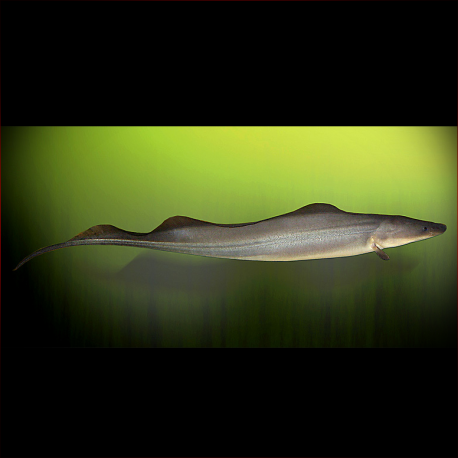More info
Datasheet
| Minimum Tank Size | 8155 litres / 2154.32 US gallons |
| Maximum Size | 165.0cm / 64.96inches |
| Temperature | 23°C / 73.40°F - 28°C / 82.40°F |
| Hardness | 10-25ºdH |
| pH | 6.5-8.0 |
General Description
Gymnarchus Niloticus, commonly known as Aba Aba, is a unique species with an extended dorsal fin resembling an upside-down knifefish. It belongs to the Gymnarchidae family and can reach a maximum size of 165.0cm. The fish features weak electrical discharge used for navigation and communication, making it a fascinating sight in motion.
Aquarium Setup
The Aba Aba prefers dimly lit tanks with dense planting, large driftwood pieces, and twisted roots for cover. Decorations should be securely weighted down. Additionally, efficient external filtration is crucial, with minimal water movement. A sump-type filter is recommended due to the species' destructive nature towards tank equipment. Water conditions should maintain a pH of 6.5-8.0, hardness of 10-25dH, and a temperature range of 23-28°C.
Behaviour
Known for its predatory nature, extreme aggression, and territorial behavior, the Aba Aba is unsuitable for community tanks or mixed-species setups. It is intolerant of conspecifics and should be kept as a solitary specimen. Even larger fish are not safe from its attacks, as it can cause severe injuries. Caution is advised during feeding and tank maintenance, as the fish possesses sharp teeth and a powerful bite capable of causing significant harm.
Feeding and Diet
Being carnivorous, G. Niloticus primarily feeds on fish and aquatic invertebrates in the wild. In captivity, they readily accept meaty live or frozen foods like fish fillets, prawns, mussels, and earthworms. Avoid feeding live fish or mammal meat like beef heart, as it can be detrimental to the fish's health. While some individuals may accept dried foods, most prefer fresh or frozen meaty offerings.
Reproduction & Dimorphism
Captive spawning of the species has not been observed. In their natural habitat, the Aba Aba migrates to flooded areas during the wet season for breeding. Males construct bubble nests amongst aquatic vegetation for egg deposition. The eggs hatch in approximately five days, with no parental care from the adults afterwards. Sexual dimorphism in G. Niloticus remains unknown.
Habitat and Distribution
Inhabiting slow-moving streams, swamps, and marshes with dense vegetation, the Aba Aba has a vast natural range across the northern half of Africa. Recorded in countries like Egypt, Nigeria, Senegal, and Mauritania, the species prefers habitats rich in micro-organisms and aquatic vegetation for breeding. Its unique appearance limits the likelihood of misidentification despite the patchy distribution.

